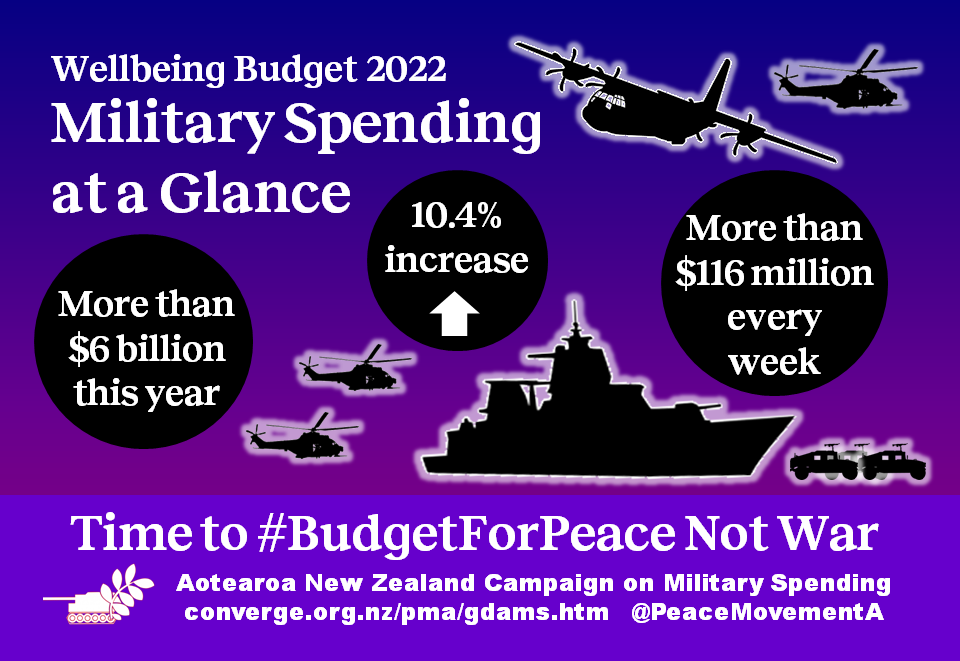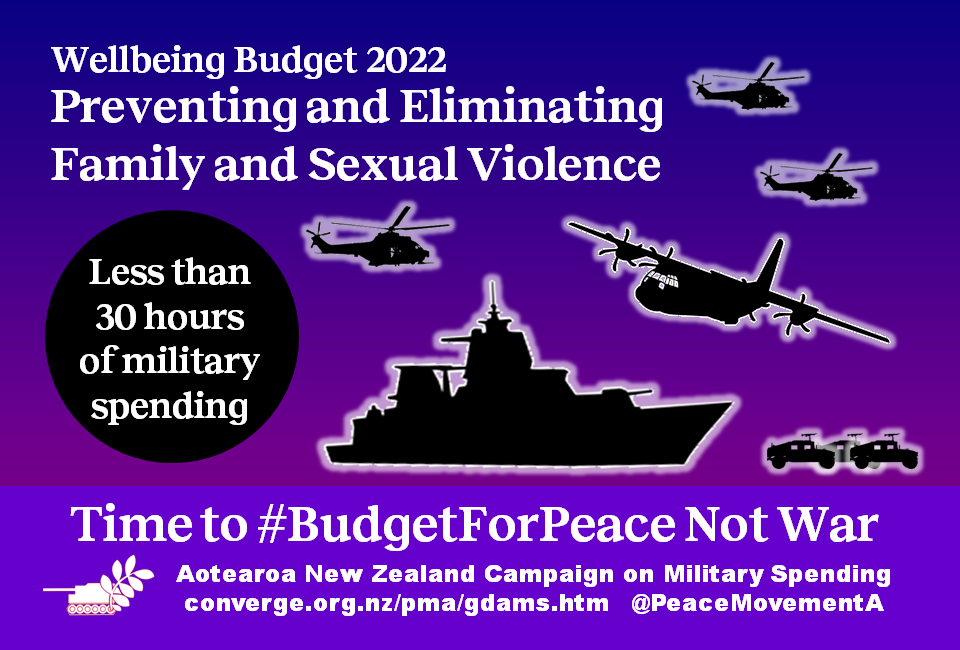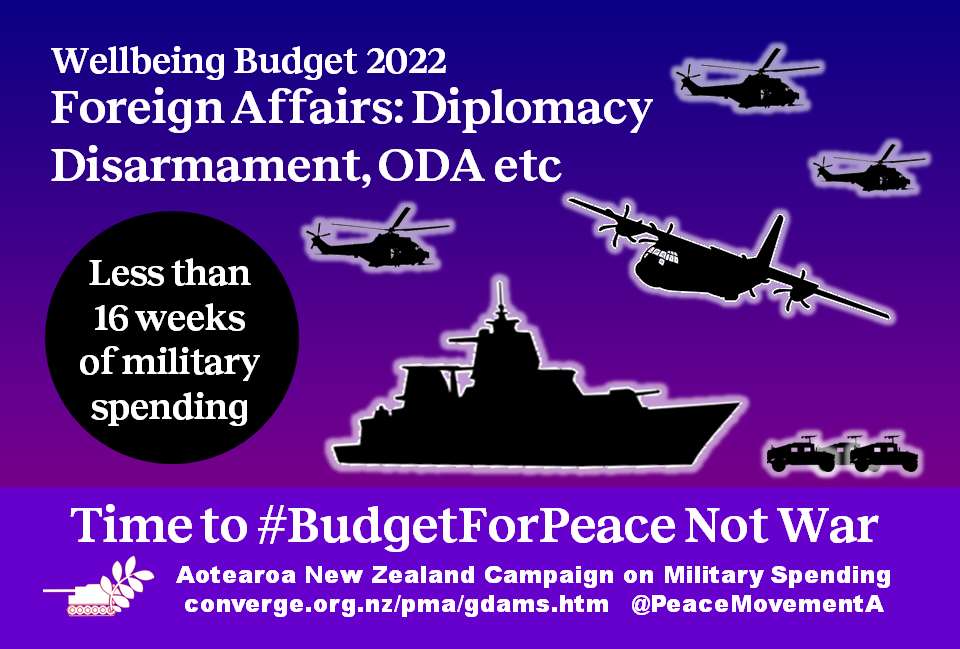Military spending increases again: Time to #BudgetForPeace
Aotearoa New Zealand Campaign on Military Spending
19 May 2022
Military spending increases again: Time to #BudgetForPeace![]() Military spending allocated in the 2022 Wellbeing Budget is $6,077,484,000 – an average of more than $116.8 million every week, and a 10.4% increase on actual spending in 2021. [1]
Military spending allocated in the 2022 Wellbeing Budget is $6,077,484,000 – an average of more than $116.8 million every week, and a 10.4% increase on actual spending in 2021. [1]
This year’s increase illustrates yet again that the government remains stuck in the same old thinking about ‘security’, choosing to focus on an outdated narrow concept of military security rather than real security that gives all New Zealanders the chance to flourish. As but one example, the Budget allocation for preventing and eliminating family and sexual violence, which would provide real security to so many vulnerable individuals and families, is equivalent to less than 30 hours of the amount of military spending.

It is shameful that funding for combat-ready armed forces continues to be a spending priority when there are so many other major issues facing Aotearoa: the shocking levels of poverty and social inequality, lack of affordable housing, failing health system and substandard hospital buildings, insufficient action on climate change, and a range of other areas requiring urgent attention. Military spending negatively impacts on all of these by diverting resources that could be put to better use.
Similarly, diplomacy and negotiation are more positive ways for New Zealand to relate to communities in other parts of the world instead of deploying combat-ready armed forces overseas, but the total amount allocated for the Ministry of Foreign Affairs (including overseas development assistance) is only 29.4% of the amount of military spending.For decades successive governments have stated that there is no direct military threat to this country; and even if there was, the New Zealand armed forces are not of a sufficient size to deter any military aggression, yet military spending keeps increasing.

Rather than continuing to focus on outdated narrow military security concepts, we urgently need to transition from maintaining combat-ready armed forces to civilian agencies that meet the wider security needs of all New Zealanders and our Pacific neighbours. Given New Zealand’s comparatively limited resources, the desperate need for substantially increased social funding domestically, as well as the urgent need for climate justice in the Pacific and globally, it simply makes no sense to continue to spend billions on combat equipment and activities.
Fisheries and resource protection, border control, and maritime search and rescue could be better done by a civilian coastguard with inshore and offshore capabilities, equipped with a range of vehicles, vessels and aircraft that are suitable for our coastline, Antarctica and the Pacific, which – along with equipping civilian agencies for land-based search and rescue, and for humanitarian assistance here and overseas – would be a much cheaper option as none of these require expensive combat hardware. [2]
In addition, that would surely be a more useful contribution than New Zealand continuing to be involved in pointless gunboat diplomacy like joining the UKUS carrier strike to parade the new British aircraft carrier around the Pacific last year; or being involved in destructive full-scale combat assaults on land and sea through military training “exercises” such as RIMPAC that are not only costly, but also harmful to the environment, marine and other life, while increasing New Zealand’s climate-destroying emissions and wasting non-renewable resources.
If there is any lesson to be learnt from the global pandemic and escalating climate emergency, it must be that new thinking about how best to meet our real security needs is essential. Instead of relying on an ideology that focuses on outdated narrow military security concepts, New Zealand could – and should – lead the way. Instead of continuing down the path of spending $20 billion plus (in addition to the annual military budget) over the next decade for increased combat capability, including new military aircraft and warships, this is an opportune time to choose a new and better way forward.

A transition from combat-ready armed forces to civilian agencies, along with increased funding for diplomacy, would ensure New Zealand could make a far more positive contribution to wellbeing and real security for all New Zealanders, and at the regional and global levels, than it can by continuing to maintain and re-arm small but costly armed forces. Only then will we finally see a genuine Wellbeing Budget that enhances human security, resilience, and prosperity.
• Further information is available on the Aotearoa New Zealand Campaign on Military Spending page, http://www.converge.org.nz/pma/gdams.htm (if the click link doesn’t work in your browser, please copy and paste it).
• References
[1] This is the total across the three Budget Votes where most military expenditure is itemised: Vote Defence Force $4,898,349,000; Vote Defence $1,177,959,000; and Vote Education $1,177,959,000. The 2021 estimated actual expenditure total was $5,504,811,000 ($316,461,000 more than was allocated in Budget 2021, eg, ‘Military spending increases in Budget 2021’, Peace Movement Aotearoa, 20 May 2021
[2] For more information about the multiple costs of maintaining combat-ready armed forces, and better ways forward, see ‘Welfare or Warfare? Submission on Budget Policy Statement 2022’, Peace Movement Aotearoa, 28 January 2022, at www.converge.org.nz/pma/budget-policy-sub,jan2022.pdf



